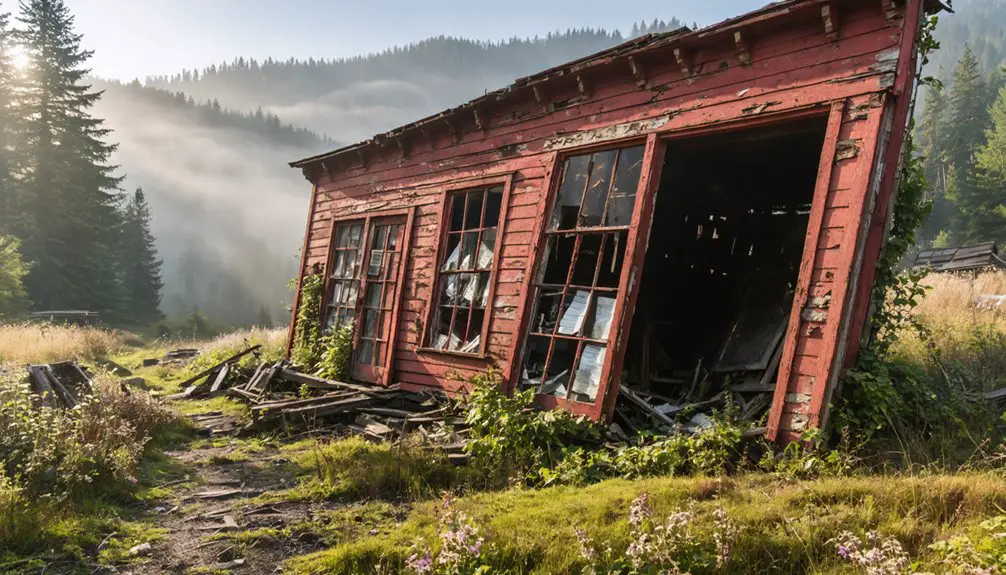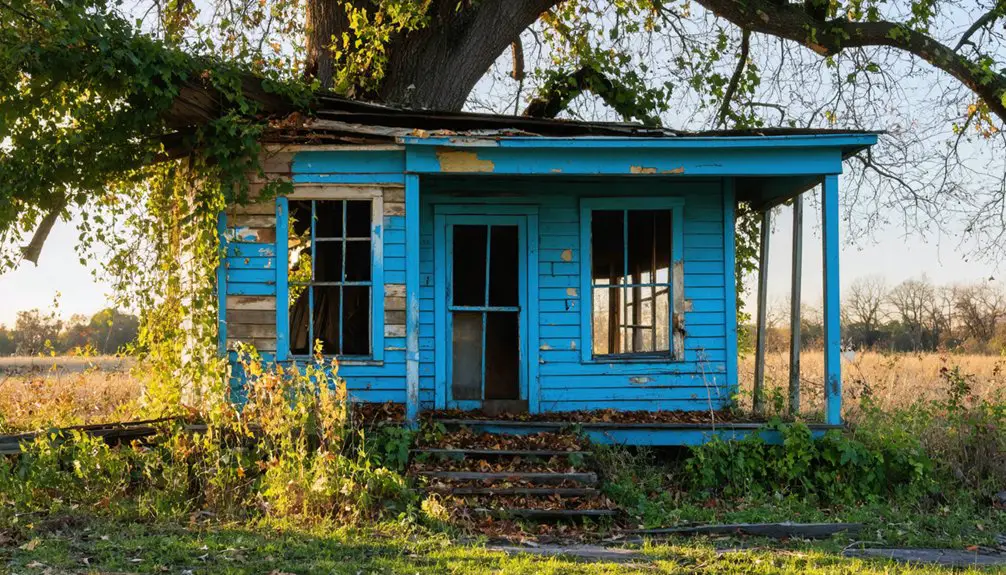You’ll find Snyder Township’s story in Jefferson County, Pennsylvania, where early 1820s farming families gave way to a bustling coal mining hub. The Northwestern Mining and Exchange Company controlled 6,000 acres during peak operations, with the Pine Forest Shaft becoming the main coal outlet by 1867. After decades of prosperity, the town declined due to mine closures, mechanization, and foreign competition. Today, you’ll discover abandoned railways, empty buildings, and fascinating local legends haunting its quiet streets.
Key Takeaways
- Snyder transformed from a thriving coal mining community into a ghost town following the decline of the Northwestern Mining and Exchange Company.
- Underground fires, environmental hazards, and dangerous ground conditions forced many residents to relocate, similar to Centralia’s fate.
- The township experienced significant population decline, with a 2.58% loss between 2020-2025 and widespread property abandonment.
- Abandoned railways, empty buildings, and continuous smoke from ground vents characterize the current ghost town landscape.
- Local legends, including ghostly sightings at Bower’s Mountain and Snyder Cemetery, add to the town’s eerie abandoned atmosphere.
The Rise of a Mining Community
While Snyder Township’s early history began with farming settlers in the 1820s, its transformation into a thriving mining community was rooted in its rich geological foundations.
You’ll find evidence of community resilience in how the Brockway family and other pioneers cleared dense forests to establish farmland, adapting to the challenging terrain.
The region’s true potential emerged through industrial innovation when companies discovered the valuable Freeport Lower coal seam, averaging four feet thick.
The rich Freeport Lower coal seam unlocked the region’s industrial future, transforming a rural landscape into a powerhouse of mining innovation.
By the 1870s, railroads revolutionized the area’s development, enabling timber harvesting and coal extraction on an unprecedented scale.
The Northwestern Mining and Exchange Company controlled nearly 6,000 acres of mineral rights, while the Snyder family’s cement operations, complete with underground tunnels and canal boats, showcased the diverse industrial landscape that would define this burgeoning settlement.
The township’s abundant Homewood sandstone deposits in the northern uplands contributed significantly to its industrial development.
Like many areas in Pennsylvania, the region’s iron ore processing at local furnaces played a vital role in its economic growth during the industrial period.
Life in Snyder’s Peak Years
During Snyder’s peak years, you’d have found most residents working long, hazardous shifts in the coal mines for modest wages tied to mining output and the company-controlled economy.
Your daily life would’ve revolved around strict mining schedules, with social interactions centered on community gatherings in church basements and local halls. The town’s natural landscape was dominated by the nearby Snyder Middleswarth Natural Area, which has preserved ancient forest stands since 1902.
You could’ve purchased basic necessities at the town’s small stores, though the limited road infrastructure meant most goods arrived by rail, keeping the community relatively self-contained. The town’s underground mining tunnels would later prove dangerous, as similar tunnels in coal deposit fires would devastate other Pennsylvania mining communities.
Mining Jobs and Wages
As Snyder’s mining operations expanded in the mid-19th century, the Northwestern Mining and Exchange Company emerged as a dominant force, controlling over 5,700 acres of coal-rich land valued at $11,582.
You’d find miners working grueling 10-12 hour shifts in underground drift mines that extended up to a mile long, facing constant dangers from flooding and poor ventilation. The operation included nine cement kilns that ran continuously until 1928. Job safety was minimal, and you’d risk your life daily in the hazardous shafts and furnaces. The Combined Metals Reduction Company later became a major player in mining operations under E.H. Snyder’s leadership.
While wage fluctuations were common, skilled workers like furnace operators and cement mill workers earned more than general laborers.
Mining jobs supported entire families, with men taking on the most physically demanding roles while some women and children worked in support positions.
The industry’s success brought relative prosperity to Snyder compared to farming communities.
Daily Community Activities
Life in Snyder flourished through vibrant community gatherings that brought residents together despite their demanding work schedules.
You’d find social gatherings taking place regularly in community halls and church basements, where residents enjoyed dances, meetings, and club activities. During warmer months, you could participate in seasonal picnics and fairs featuring games and music, while winter months drew folks indoors for card games and board games.
Like the saloons and hotels of historic Centralia, the local school served multiple purposes, hosting plays and talent shows that showcased the town’s cultural spirit. The anthracite coal deposits fueled the town’s economic prosperity, enabling residents to maintain their active social lives.
The local school served multiple purposes, hosting plays and talent shows that showcased the town’s cultural spirit.
Churches were central to daily life, offering weekly services and youth programs. You’d often find families hosting informal potlucks, while children played freely in the surrounding forests.
The general store and post office kept you connected to news and information from beyond Snyder’s borders.
Local Business and Trade
While coal mining formed the backbone of Snyder’s economy, a diverse network of businesses emerged to support the thriving industrial hub. You’d find up to 14 general stores and grocery shops stocking miners’ daily necessities, alongside 27 saloons and five hotels serving both residents and transient workers.
This economic diversification created a self-sustaining commercial ecosystem. Just as in nearby regions, anthracite coal mining drove much of the local prosperity and job creation. Similar to place name confusion that exists with other mining towns, Snyder developed its own distinct identity through its commercial ventures.
The community’s resilience showed through its integrated infrastructure, where railroads and canals connected local merchants to broader markets. Banks and post offices managed the flow of capital, while boarding houses and taverns like Bull’s Head provided essential services to the workforce.
Even as mining companies wielded significant influence over development, independent businesses flourished, creating a vibrant local economy that lasted until the Great Depression triggered widespread closures and decline.
Economic Decline and Exodus
As you explore Snyder’s history, you’ll discover that its economic importance began to crumble when the local mines closed, mirroring the fate that would later befall Centralia.
The loss of mining jobs forced many residents to seek work elsewhere, causing a steady stream of departures throughout the decade.
The town’s population shrank dramatically as families packed up and left, leaving behind empty homes and shuttered businesses that would never reopen.
Mining Jobs Vanish
During the mid-twentieth century, Snyder Township’s mining workforce faced devastating losses as mechanization revolutionized coal extraction methods. Job automation meant fewer miners could extract more coal, while economic shifts sparked a downward spiral in employment.
You’d find the Northwestern Mining and Exchange Company’s vast 5,800-acre operation requiring just a fraction of its former workforce.
The decline didn’t stop there. By the late 1970s, you’d see foreign competition crushing U.S. steel demand, environmental regulations tightening, and safer energy alternatives emerging.
Coal companies started filing for bankruptcy, and union membership plummeted. The dangerous nature of mining – which had claimed thousands of Pennsylvania miners’ lives in the early 1900s – further discouraged new workers from entering the industry, accelerating the exodus from mining towns like Snyder.
Population Drifts Away
Once mining jobs disappeared from Snyder Township, a steady population decline took hold.
Population trends reveal a consistent exodus, with the township losing 2.58% of its residents between 2020 and 2025. You’ll find similar community challenges across Snyder County, which has seen its numbers drop from a peak of 40,621 in 2017 to 39,506 by 2022.
- Empty driveways where families once parked multiple vehicles
- “For Sale” signs dotting the aging neighborhoods
- Fewer children playing in local parks and schoolyards
- Quiet streets where bustling foot traffic used to be common
The demographic shift is stark – an aging population with a median age of 39.7 years remains, while younger residents seek opportunities elsewhere.
Despite stable median household incomes around $68,000, limited job prospects continue driving working-age adults from the area.
Local Legends and Lore

The legends of Snyder, Pennsylvania paint a haunting portrait of the town’s complex history through supernatural tales and tragic events.
You’ll hear stories of ghostly sightings on Bower’s Mountain, where a towering apparition leads visitors to a 1932 plane crash site before vanishing into the moonlit night. The figure’s identity remains disputed, possibly tied to James Hazel or a murdered tannery inspector.
A ghostly guide prowls Bower’s Mountain at night, leading wanderers to a decades-old plane wreck before dissolving into darkness.
In Snyder Cemetery, you’ll find tales of Conrad Senior’s spirit, marked by glowing red eyes that chase nighttime visitors, while green lights and mysterious fog emanate from the remaining tombstones.
The town’s mining history and Underground Railroad connections have spawned tragic tales, including a female runaway slave mistakenly shot by hunters and now reportedly buried in Pioneer Cemetery.
What Remains Today
Despite decades of decline, modern-day Snyder retains sparse but notable physical remnants of its former existence. Current residents navigate a transformed landscape where underground fires have reshaped the town’s physical and environmental characteristics.
Today, you’ll find dangerous ground conditions and environmental hazards that have forced most inhabitants to relocate, leaving behind deteriorating infrastructure and unstable terrain.
- Smoke rises continuously from ground vents and cracks, creating an otherworldly atmosphere
- St. Mary’s Church stands defiant against decay, still hosting weekly services
- Abandoned roads and railways cut through the landscape like scars of a bygone era
- Warning signs dot the perimeter, marking hazardous areas where sinkholes threaten to swallow the unwary
Legacy in Pennsylvania’s Coal Country

As Pennsylvania’s coal industry evolved throughout the 1800s, Snyder emerged as a pivotal player in the state’s anthracite mining legacy.
You’ll find Snyder’s influence woven throughout the region’s industrial evolution, from George W. Snyder’s $75,000 purchase of Pine Forest collieries in 1854 to the establishment of Brush Creek Mining Company in 1913.
The coal heritage of this area showcases the shift from family-owned operations to corporate mining ventures.
Under George W. Snyder & Company’s leadership, Pine Forest Shaft became the main coal outlet by 1867, while later developments brought modern power infrastructure and extensive rail connections.
Pine Forest Shaft’s rise under Snyder’s leadership marked a turning point, ushering in modernization and expanded transportation networks across Pennsylvania’s coal region.
The town’s impact extended beyond mining, shaping regional labor patterns and community development, with total coal shipments reaching over 3.2 million tons before operations shifted to newer ventures under Brush Creek Mining Company.
Frequently Asked Questions
Are There Any Accessible Mine Shafts Still Remaining in Snyder Today?
You won’t find accessible mine shafts in the area today, as they’ve been sealed or collapsed. Mine exploration isn’t possible due to serious safety concerns like unstable ground and toxic gases.
What Was the Peak Population of Snyder During Its Mining Heyday?
You’ll find historical records showing peak population reached around 1,300 residents by 1910 during Snyder’s mining history, before experiencing dramatic population decline as coal operations eventually ceased.
When Was the Last Resident Known to Have Lived in Snyder?
Like whispers from abandoned mine shafts, ghost stories fade with time. You won’t find definitive records of the last resident in Snyder, though most inhabitants had departed by the early 1900s.
Does Anyone Still Own Property or Land Titles in Snyder?
You won’t find clear land ownership records or active property rights in Snyder today. Most parcels have likely reverted to state or county control through abandonment, though some cemetery plots retain unclear titles.
Are There Any Preserved Artifacts From Snyder in Local Museums?
You won’t find explicitly labeled Snyder artifacts in local museums, though regional historical societies like the Warren County Historical Society might preserve unlabeled items through their broader local history and artifact preservation efforts.
References
- https://thepennsylvaniarambler.wordpress.com/2019/02/20/spirits-of-snyder-cemetery/
- http://paoddities.blogspot.com/2020/04/springtime-in-pandemonium.html
- https://en.wikipedia.org/wiki/List_of_ghost_towns_in_Pennsylvania
- https://en.wikipedia.org/wiki/Centralia
- https://www.iridetheharlemline.com/2010/04/07/an-old-adventure-to-centralia-pennsylvania-–-the-burning-ghost-town/
- https://www.pa-roots.com/jefferson/katescotthistory/chapter39.html
- https://sah-archipedia.org/essays/PA-02-0004-0003
- https://www.centuryhouse.org/nrhp-snyder-cement-works/
- https://archiveswest.orbiscascade.org/ark:80444/xv794493
- https://kleinmanenergy.upenn.edu/wp-content/uploads/2020/08/Reimagining-Pennsylvanias-Coal-Communities_0-1.pdf



